UIKit used to support TableView Cell that enabled a Blue info/disclosure button. The following was generated in SwiftUI, however getting the underlying functionality to work is proving a challenge for a beginner to SwiftUI.
Generated by the following code:
struct Session: Identifiable {
let date: Date
let dir: String
let instrument: String
let description: String
var id: Date { date }
}
final class SessionsData: ObservableObject {
@Published var sessions: [Session]
init() {
sessions = [Session(date: SessionsData.dateFromString(stringDate: "2016-04-14T10:44:00+0000"),dir:"Rhubarb", instrument:"LCproT", description: "brief Description"),
Session(date: SessionsData.dateFromString(stringDate: "2017-04-14T10:44:00+0001"),dir:"Custard", instrument:"LCproU", description: "briefer Description"),
Session(date: SessionsData.dateFromString(stringDate: "2018-04-14T10:44:00+0002"),dir:"Jelly", instrument:"LCproV", description: " Description")
]
}
static func dateFromString(stringDate: String) -> Date {
let dateFormatter = DateFormatter()
dateFormatter.locale = Locale(identifier: "en_US_POSIX") // set locale to reliable US_POSIX
dateFormatter.dateFormat = "yyyy-MM-dd'T'HH:mm:ssZ"
return dateFormatter.date(from:stringDate)!
}
}
struct SessionList: View {
@EnvironmentObject private var sessionData: SessionsData
var body: some View {
NavigationView {
List {
ForEach(sessionData.sessions) { session in
SessionRow(session: session )
}
}
.navigationTitle("Session data")
}
// without this style modification we get all sorts of UIKit warnings
.navigationViewStyle(StackNavigationViewStyle())
}
}
struct SessionRow: View {
var session: Session
@State private var presentDescription = false
var body: some View {
HStack(alignment: .center){
VStack(alignment: .leading) {
Text(session.dir)
.font(.headline)
.truncationMode(.tail)
.frame(minWidth: 20)
Text(session.instrument)
.font(.caption)
.opacity(0.625)
.truncationMode(.middle)
}
Spacer()
// SessionGraph is a place holder for the Graph data.
NavigationLink(destination: SessionGraph()) {
// if this isn't an EmptyView then we get a disclosure indicator
EmptyView()
}
// Note: without setting the NavigationLink hidden
// width to 0 the List width is split 50/50 between the
// SessionRow and the NavigationLink. Making the NavigationLink
// width 0 means that SessionRow gets all the space. Howeveer
// NavigationLink still works
.hidden().frame(width: 0)
Button(action: { presentDescription = true
print("\(session.dir):\(presentDescription)")
}) {
Image(systemName: "info.circle")
}
.buttonStyle(BorderlessButtonStyle())
NavigationLink(destination: SessionDescription(),
isActive: $presentDescription) {
EmptyView()
}
.hidden().frame(width: 0)
}
.padding(.vertical, 4)
}
}
struct SessionGraph: View {
var body: some View {
Text("SessionGraph")
}
}
struct SessionDescription: View {
var body: some View {
Text("SessionDescription")
}
}
The issue comes in the behaviour of the NavigationLinks for the SessionGraph. Selecting the SessionGraph, which is the main body of the row, propagates to the SessionDescription! hence Views start flying about in an un-controlled manor.
I've seen several stated solutions to this issue, however none have worked using XCode 12.3 & iOS 14.3
Any ideas?
